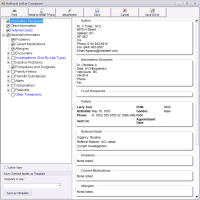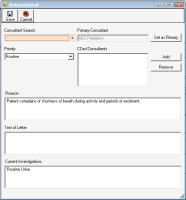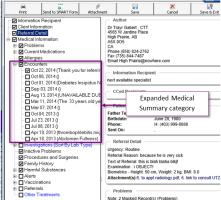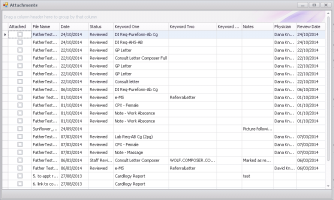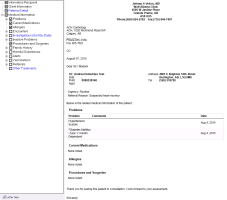Creating a referral letter using the Referral Letter Composer
The Referral Letter Composer is a letter creation tool that enables you to enter the basic letter message and to select documents and additional medical information from the patient’s record to attach to the letter. The EMR produces a professional letter that includes all the information you selected.
Steps
| 1. | Initiate a referral and complete the new referral details. See Initiating referrals. |
Note: To create a letter based on a previously started referral, open the patient’s medical summary (see Opening the medical summary), click the Referrals tab, and double-click the referral you want.
| 2. | On the New Referral (or Existing Referral) window, within the Enter Text of Letter field, type the content of your letter. |
Tip: If the Enter Text of Letter field is too small for your letter content, click Expand Area ![]() . The EMR expands the text area and hides the lower fields. When you finish adding your text, click Minimize Area
. The EMR expands the text area and hides the lower fields. When you finish adding your text, click Minimize Area ![]() .
.
| 3. | Click Compose |
| 4. | If you did not select the MSP Referral Sent check box, the EMR prompts you to “Send Referral to MSP?”. Perform one of the following actions: |
If you want to bill MSP for the referral, click Yes. The EMR automatically creates a bill with the patient's name, fee code and specialist’s name to whom the patient is referred.
If you do not want ill MSP for the referral at this time, click No.
The Referral Letter Composer displays the following sections by default:
| 5. | To include additional medical information, from left pane, select the check box beside each category that you want to include in the referral letter (such as problems, current medications, allergies, or investigations). |
To include only specific items from a category, expand the category, and select the specific items you want.
Tip: Clear any pre-selected item to exclude it from the referral letter. For example, if you select the Current Medications, check box, all of the patient’s medications are included. Clear the check box for medications that you want to exclude from the referral letter.
You cannot edit most information in the Referral Letter Composer window directly from the Referral Letter Composer window. Instead you must edit the information from the source.
For example, you must:
Add or edit allergies in the patient’s medical summary.
Edit recipient contact information in the Edit Consultant Information window.
Edit patient information in the Patient Maintenance window.
Items that display in the left pane in blue text are customizable. To customize these items, right-click the blue text.
Referral Detail: You can modify the primary and CCed consultants, referral priority, referral reason, letter text, and current investigations.
Investigations: You can change the sort order of a patient’s listed investigations.
Other Treatments: You can enter details of the patient’s non-medication treatments.
| 6. | To attach documents to the referral letter |
| b) | In the Attached column, select the check box beside the documents you want. |
Tip: Use the filtering options and Search field to easily find a document.
| c) | When you finish, click Close |
You can attach only files that are available in the Documents tab of the patient’s medical summary.
To attach the prenatal form to a referral letter, you must save the prenatal form as a PDF in the medical summary Documents tab. You can then attach the prenatal form as you do other documents.
| 7. | To preview the referral letter, on the bottom left of the window, select the Letter View check box. The EMR displays the letter in the format it will be printed with a list of any attachments at the bottom. |
Tip: To modify the letter format before it is sent, click Send to SMART Form ![]() . Edit the letter in Microsoft Word, and then click Save
. Edit the letter in Microsoft Word, and then click Save ![]() . The EMR saves the edited letter in patient’s medical summary, in the Documents tab.
. The EMR saves the edited letter in patient’s medical summary, in the Documents tab.
| 8. | To print, fax, or save (as a PDF) your completed referral letter: |
| a) | Click Print |
| b) | Perform one of the following actions: |
To send the referral letter to your default printer, click Quick Print.
To select a specific printer or fax machine before printing or sending, click Print.
To save the referral letter as a PDF file, click the Collate to PDF check box, and then click Quick Print.
Note: If you are printing or faxing the referral letter, ensure that the Collate to PDF check box is cleared.
| 9. | Click Save & Exit |
| 10. | Open the patient’s referral from the Referrals tab in the medical summary. |
| 11. | In the LETTER COMPLETED area, indicate the status of the referral letter. For details about each status, see Managing referral letters. |
| 12. | Click Save & Close Referral |
© 2018 
